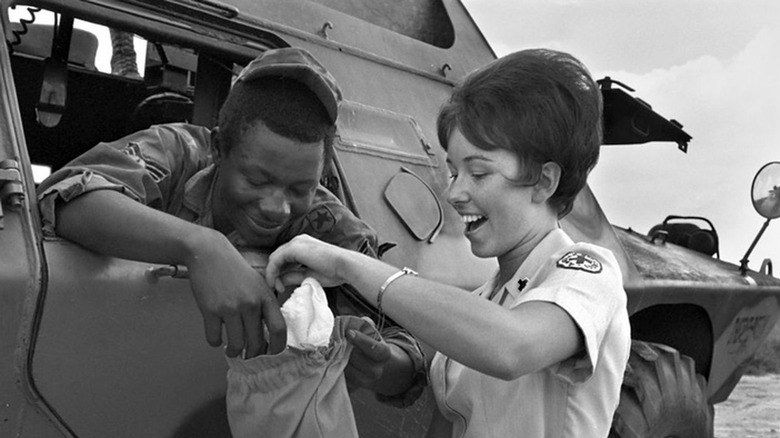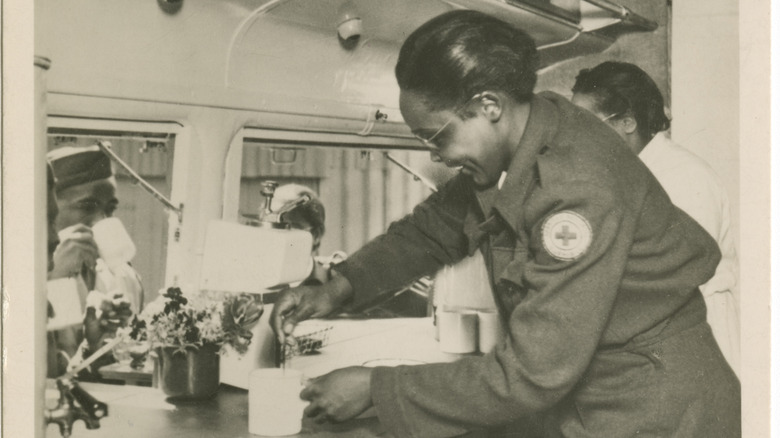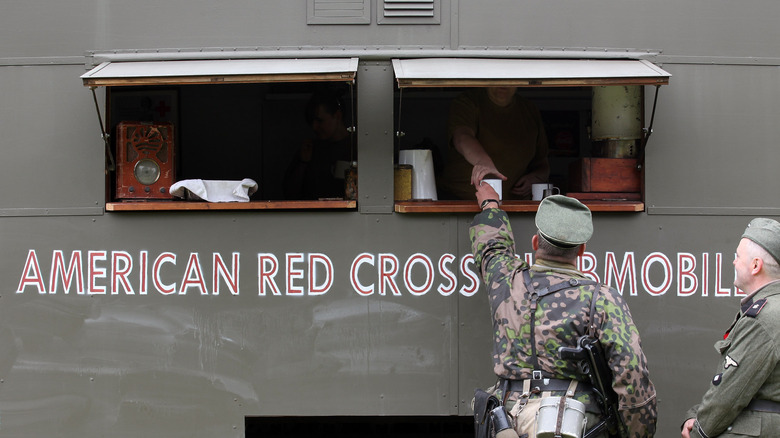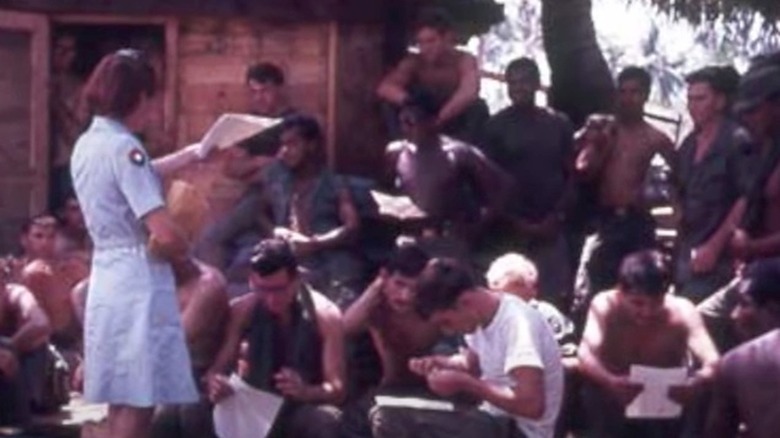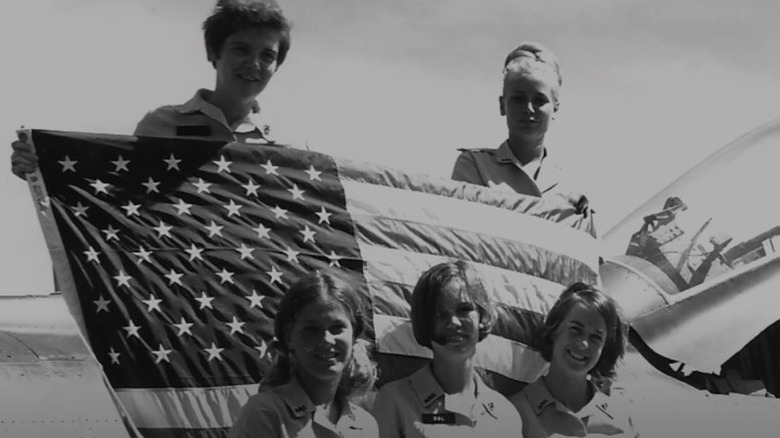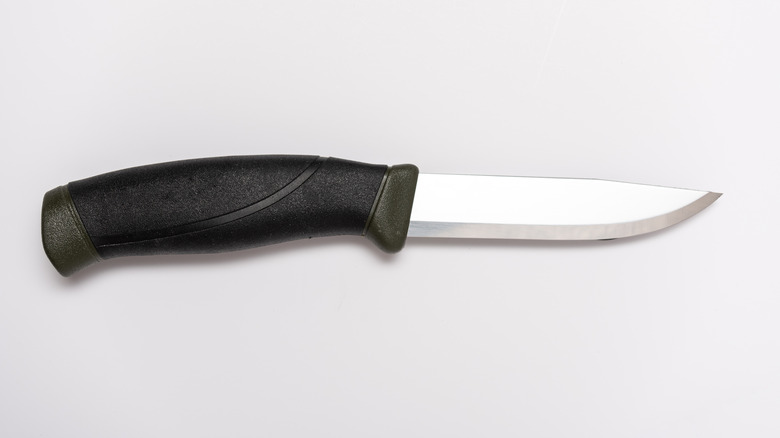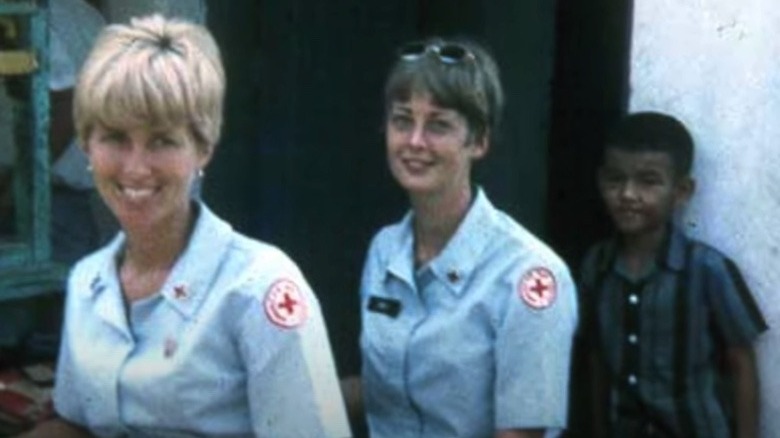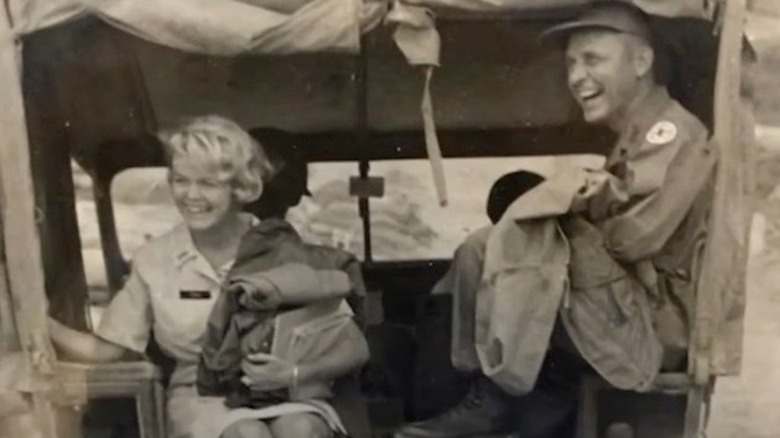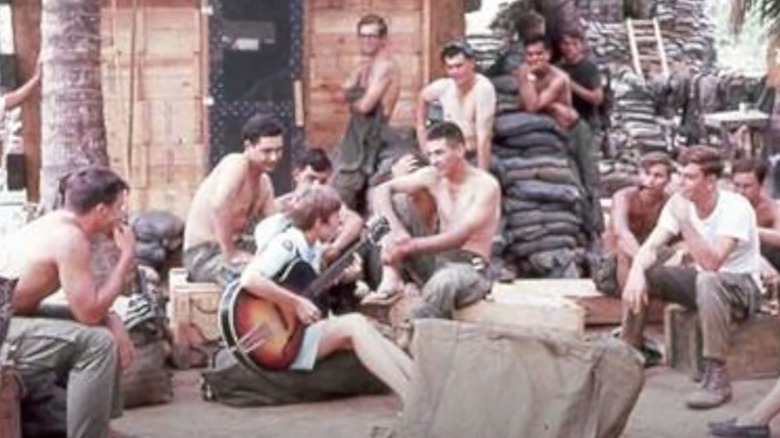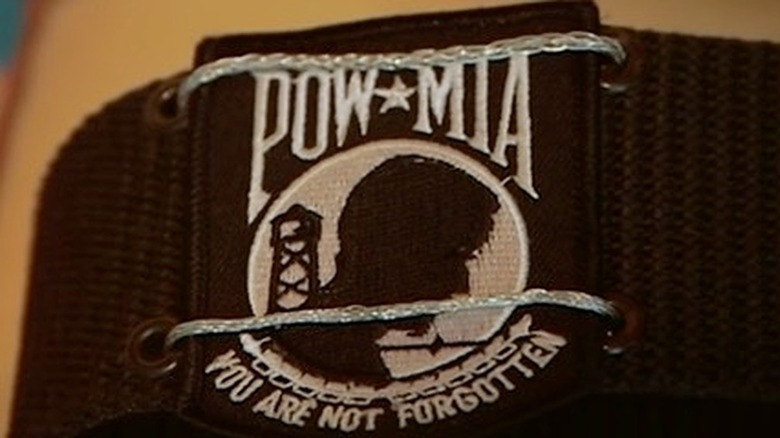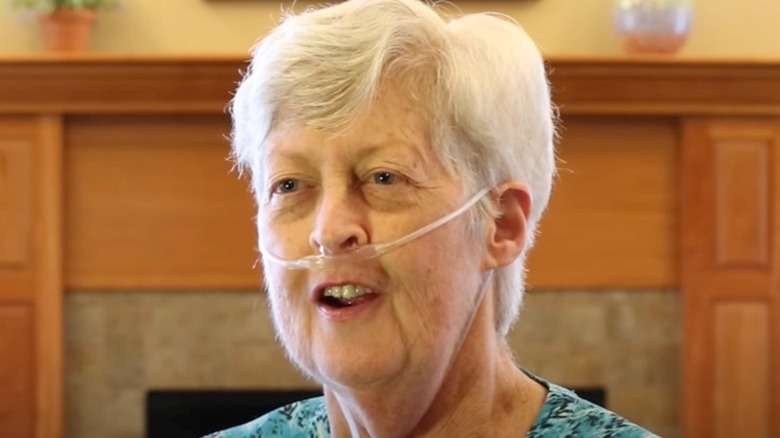The Untold Truth Of The Vietnam War's 'Donut Dollies'
Though many of the harsh realities of the Vietnam War were splayed across American newspapers and television sets as journalists reported from Ho Chi Minh City, formerly Saigon, some stories still went untold. Among those were the ones that involved women's volunteer contributions overseas, like those of an elite Red Cross group affectionately known as Donut Dollies, according to The Desert Sun. Britannica notes that the Vietnam War became known as the "first television war" because of technological advances in film and satellite transmission, and more than ever before, the world could see how brutal the conflict was, which made Americans eligible to be drafted angry and afraid.
As the war raged on without an end in sight, many college-educated young people became increasingly opposed to it with each passing day. They rejected the mounting American presence and suppression of free speech on campuses as they became disillusioned with the United States' approach to the situation in Vietnam, History reported. Many young people across college campuses joined anti-war movements and pushed back against being drafted. But some women saw all of this happening and went by choice to help the American soldiers overseas feel some sense of home and to see the truth for themselves. They were called Donut Dollies.
Donut Dollies weren't the official name
The Donut Dollies of the Vietnam War were officially called the Supplemental Recreational Activities Overseas staff, a section of the Red Cross, according to the Red Cross. It just doesn't have the same ring to it, and the name Donut Dollies represented the comforting nature of the young American women that came to Vietnam. But the name began even earlier with the "Donut Lassies" of World War I. When the initial idea to have female volunteers offer a respite from the horrors of war was launched by the Salvation Army, the intention was to boost morale by reminding soldiers of some of the joys of home, like the presence of a friendly girl-next-door type, the chance to play games, talk, and get coffee and food, according to The Smithsonian. Because they couldn't serve, women volunteered. During World War I, one of their unexpected ways to help morale was making donuts.
In 1917, two women named Margaret Sheldon and Helen Purviance had the idea that making hot donuts would bring smiles to soldiers' faces. They could get the ingredients needed, and so they set about bringing happiness to the men with unexpected donuts. As the popularity of their pastries increased, between the pair of them they figured out how to make 2,500 donuts a day, according to The Smithsonian. This name stuck, and it followed women volunteers in the Red Cross for years to come, even when they weren't serving donuts.
The moniker lasted through four wars
Originally started during World War I, variations of the donut-themed names and contributions continued through World War II, the Korean War, and the Vietnam War. As All That's Interesting reported, what began as a makeshift practice in World War I with two volunteers became a key focus in wars to follow. During World War II, when the name Donut Dollies became popular for the women of the Supplemental Recreational Activities Overseas (SRAO) volunteer group, the Doughnut Corporation of America equipped the Donut Dollies with 468 machines capable of making 48 dozen donuts an hour.
The ranks of Donut Dollies grew substantially during the Vietnam War, with 627 women volunteering under the name to put themselves in harm's way. They would serve a year at a time, according to the Red Cross. The program's height was in 1969, and it's estimated that each month, the women of the SRAO volunteer group helped close to 300,000 servicemen. Even when the means of boosting morale changed between wars, the spirit of bringing joy in small ways remained.
They didn't serve donuts in Vietnam
While the original Donut Dollies used the ingredients they had at hand to make warm baked treats, AARP reported that it was too hot in Vietnam to enjoy donuts. Instead, they served things like Kool-Aid and other refreshments, and they offered a reminder of something soldiers were desperately missing — the normalcy of home. Even though they weren't making donuts, calls would come in requesting the Donut Dollies after a unit was decimated. They would show up and see which men wanted to talk. The name represented much more than girls handing out a breakfast item — they brought hope and comfort with them. One Donut Dolly, Rachel Torrance, told PBS, "Our mission over there was to break the monotony of the war and to remind them of home."
According to Spectrum News 1, many of the men that relied on the emotional support the Donut Dollies provided in Vietnam began to fall in love with them. Bobbi Stephens, who volunteered for a year, had many men confess their feelings. She told them to go home and wait and see if they still felt the same. One man did, and they ended up getting married.
They played games in war zones
When spirits were lowest, the Donut Dollies had to get creative. Their task was to boost morale, but without huge funding or psychological training. So, they would play games and trivia with the men, listen to records, and talk. One former volunteer, according to The National Museum of the United States Army, said, "Our job was to smile and be bubbly for an entire year — no matter what the situation."
That meant that even when they were scared or had seen soldiers they knew die, they still had to show up and try to boost the troops' spirits. While the armed forces had weapons, training, and gear, the Donut Dollies had the kindness and creativity to spread laughter and distraction. According to The U.S. Department of Defense, when they didn't drive between locations, they were taken in helicopters to fire bases, where they would create trivia and games based on topics the men enjoyed at home, like football and music. A former Dolly named Linda Pelegrino told the Red Cross, "It is very hard to explain to someone, 'Yeah, we played games in the war zone.' It's definitely a history of Red Cross that I wish more people knew about."
It's taken decades for their contributions to be recognized
There are many war stories that focus on fighting, death, and destruction. When photographers recounted their experiences and shared their most influential photos for places like Time, there was an absence of recognition for the contributions of American women on the ground.
According to Spectrum News 1, it took many years for the public to learn about the heroic volunteer work the Dollies did in Vietnam. In the late '80s, a television show called "China Beach" focused on characters serving in a field hospital in at a base during the war, and they consulted with a Donut Dolly named Linda Hallenbeck-Pelegrino to get details right for a character they named after her. In 2019, a documentary came out about two of the Dollies. The documentarians wrote for their IMDB synopsis that "amazingly, over 50 years since the first Donut Dollies arrived in Vietnam, many people have still never heard of them."
Three Donut Dollies died
While more than 600 women served in Vietnam as Dollies, some of them didn't return home. They were very much part of the war, and they faced similar dangers that those fighting did. Though they were supposed to be "nonsexual symbols of purity and goodness," according to The Huffington Post, they were often up against familiar threats they faced in the U.S. like sexism and sexual assault. Bobbie Lischak Trotter recounted in a Donut Dolly Dispatch that though the men were largely appreciative of the women, one told her to "go home and make babies or whatever it is you women do," and she also had to deal with an attempted assault.
According to AARP, the women also had to deal with unwanted propositions and Peeping Toms. Three even died while volunteering at what the Red Cross advertised would be the greatest year of these young women's lives. According to an avionics newsletter about Vietnam called Avel Vietnam, Lucinda J. Richter died after getting an infection at just 21. Find A Grave lists that another Dolly died in Vietnam in a Jeep accident — her name was Hannah Elizabeth Crews. And then, there was the tragic murder of Ginny Kirsch.
If you or anyone you know has been a victim of sexual assault, help is available. Visit the Rape, Abuse & Incest National Network website or contact RAINN's National Helpline at 1-800-656-HOPE (4673).
The murder of Ginny Kirsch
When they left for Vietnam, the young women that volunteered with the Red Cross likely knew that they would face some dangers, and possibly death, but not from the hands of the men they went to help. Tragically, a young volunteer named Virginia E. "Ginny" Kirsch was stabbed to death, according to the Tribune Chronicle.
Patrick M. McLaughlin, a former U.S. attorney for Northern Ohio and president of the Greater Cleveland Veterans Memorial Inc., filed a Freedom of Information Act request in order to get details about her death and wrote about them in an opinion piece for Cleveland.com. According to that report, Kirsch was only in Vietnam for two weeks before she was murdered in her own bed. The Tribune Chronicle reported that an American Army man named Gregory Kozlowski was arrested after Red Cross items were found in his possession. But the evidence was insufficient, and he was never charged. He later returned to the U.S. and was arrested for the murder of a man in the states, where he is rumored to have revealed during questioning that he had stabbed a woman in Vietnam. He was found not guilty by reason of insanity for the murder in the U.S.
The rules for joining were more strict than those for the military
In order for a man to sign up to fight in Vietnam, especially because of the draft, the requirements were fairly lax. With the anti-war movement and the war being heavily broadcasted, many people were reluctant if not vehemently opposed. According to the Selective Service System, you only needed to be 18 to be put into the draft lottery (which is still true today). The list of reasons you couldn't serve was much longer than the requirements. You couldn't be gay, hold an essential job, or have a serious health issue, according to Business Insider.
In order to be a Donut Dolly, you had to be a young woman, have a college degree, a great personality, letters of recommendation, the ability to pass physical exams, and more, according to the Red Cross. With the strict requirements, only one in six who applied to volunteer their time and talents were chosen, notes All That's Interesting. As the New York Times reported, these women also had to be able to care for the emotional scars of the soldiers.
They traveled by helicopter, Jeep, and mobile clubhouses
The women tasked with boosting morale as Donut Dollies also had to understand Red Cross procedures, Army procedures, and drive "clubmobiles," which were like traveling clubhouses in a bus design, according to former WWII clubmobiler Elma Ernst Fay. Originally, the Red Cross built service clubs to offer aid and a place to relax during the war. In 1942, to avoid having to charge servicemen for food and aid, buses were converted into traveling service clubs to offer assistance, and Donut Dollies drove them — complete with kitchens to make the treats, record players, recent books, and more.
In Vietnam, they also traveled by clubmobiles, as well as trucks, Jeeps, and helicopters into some of the most dangerous areas, according to the U.S. Department of Defense. The National Museum of the United States Army's data shows that in order to get to the servicemen during the Vietnam War, the Donut Dollies traveled more than 2 million miles to remote stations.
They were behind the scenes and on the front lines
According to The Donut Dollie Detail, Donut Dollies like Marrilee Shannon were never considered veterans, despite spending a year or more serving their country. The women had to learn how to be therapists, drivers, cooks, and more. A Donut Dolly named Connie Dugan Popel recounted to the U.S. Department of Defense that they received just two weeks of training prior to leaving for Vietnam, and many of them didn't truly understand what they were getting into.
According to the Los Angeles Daily News, Dorset Anderson, a Donut Dolly from '68 to '69 and one of the subjects of a documentary about the women, recalled that they would often have to hide in underground bunkers when the bases they were at came under fire. Mary Tsinnajinnie-Cohoe, the only Navajo Dolly, told the Gallup Sun that many of the women were likely exposed to Agent Orange, but they can't receive veteran benefits. The Dollies also didn't know what was happening back in the U.S. "We didn't really know that Vietnam was very unpopular back in the United States. We wanted to boost the morale about the American GI and so we talked about the United States in a positive way," said Tsinnajinnie-Cohoe.
Many joined to understand the war
"I was engaged to a pilot who was flying over Vietnam and was shot down and was declared missing in action. I was heartbroken and could not understand why America was in this war and what we were doing there that would get our best and brightest killed," Donut Dolly Paula Wright Haley told The Dollie Detail. So, she went to Vietnam to try to understand her loss. She was from Texas, so the soldiers called her Tex.
Another Dolly, Karen K. Jankowski, told The Washington Post that she went because she said that "hippies and everybody were against the war. I wanted to see for myself what it was." Joining at the start of the Tet Offensive, Judy Stevens became a Dolly in support of the troops and a desire to have a first-hand experience of what they were going through (via Jacksonville.com).
The program is no longer active, but some Dollies are
When the Vietnam war raged on, there was no such thing as Skype, and the ways in which the Dollies could communicate or stay in touch were few. When they returned, many of them didn't talk about the war, or know who to talk about it with that would understand, according to the Tampa Bay Times.
Now, many Dollies are connecting online with new technology, and soldiers are putting names to faces of those that saved them, according to The Washington Post. One veteran, Jim Roberts, had photographed two Donut Dollies during his time in Vietnam. After only spending a few hours with them, they were gone. He forgot their names, but he never forgot the hope that they gave him, and with the help of the internet they got to speak to each other on Zoom. The Dollies now connect online and share their stories in chat groups and pages like The Donut Dollies documentary Facebook page.
